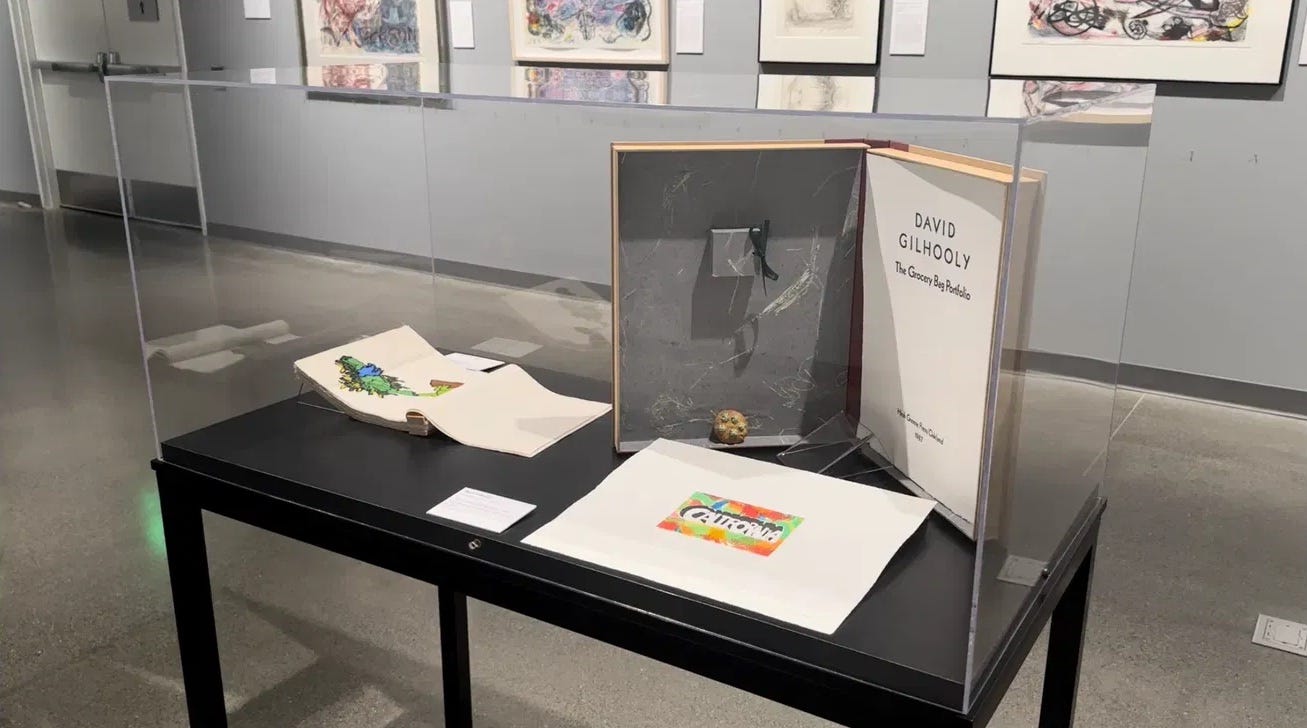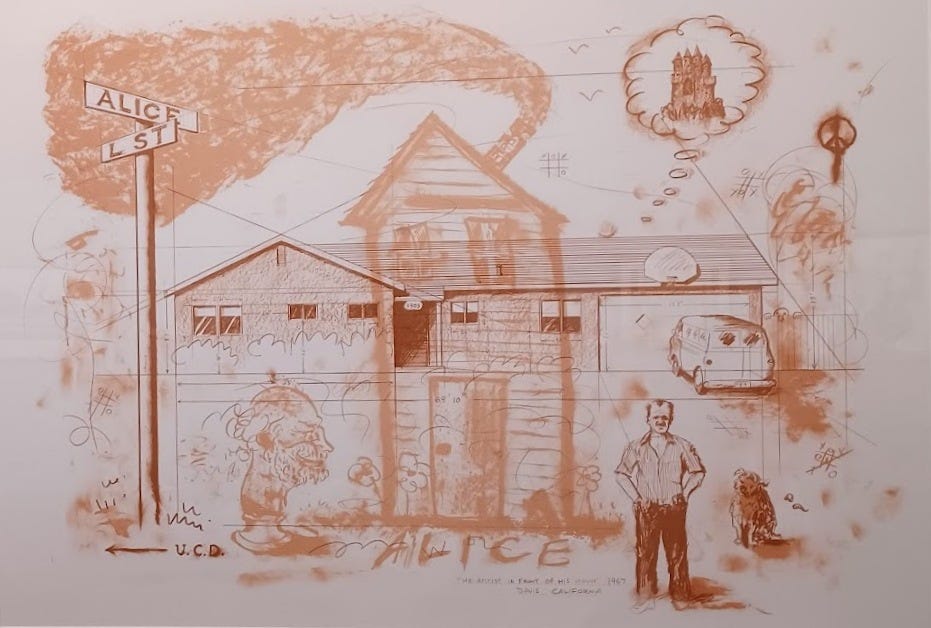Monday Musings: The Janet Turner Print Museum, California State University, Chico
Erika Esau, Art Muse Lecturer
One of my greatest pleasures is discovering new art collections in obscure or unexpected places. California offers ample opportunity for such discoveries, many of them housed on college campuses where prominent alumni or keen local collectors with ties to the institution donate their own lovingly acquired holdings to the art department or university gallery. Such is the case at the Janet Turner Print Museum on the campus of California State University, Chico. My husband and I have recently moved to Chico (population 100,000) from Pasadena and were at first concerned that we might not find many opportunities for cultural stimulation. We were thrilled to find this intriguing collection within walking distance of our new home. Everything we need in Chico seems to be, at most, about ten minutes away!
Dr. Janet Turner (1914-1988) was a professor of fine art and art education at California State University, Chico (1959-1981) and founded the University’s printmaking program, teaching generations of artists and teachers. She was herself an accomplished printmaker, having studied with Thomas Hart Benton, among others. She began collecting prints as study tools for her students, and over 40 years amassed a substantial collection, which she donated to the University upon her retirement in the 1980s.
The Museum, named in her honor, has added to that initial bequest, and today has some 4,000 prints, primarily works by twentieth-century artists. One of its most substantial donations came recently from one of Chico’s own, Reed Applegate (1943-2022), a well-known figure on the University campus, who began collecting prints in 1964 (his first purchase was a Kaethe Kollwitz). He had been one of Janet Turner’s students when he attended the University and volunteered for many years at the Museum. Described as “quirky” and unassuming, Applegate was responsible, among other initiatives, for helping to establish the city’s Museum of Northern California Art (MONCA). For his own collection, he focused primarily on prints by Northern Californian artists who were at the time relatively unknown. Just weeks after Applegate died last year, the Print Museum appointed a dynamic new curator, Rachel Skokowski, an art historian with impressive credentials, whose area of expertise is prints and printmaking. Skokowski organized an exhibition of Applegate’s donation, Northern California Horizons: The Reed Applegate Collection, which ran from August until October this year. The Museum even produced a small but comprehensive catalog of the show.
In September, Skokowski presented an introductory lecture focusing on works in the exhibition. A sign of Applegate’s popularity in the community was evident in the packed auditorium, a crowd that would be the envy of bigger museums and of better-known subjects for an exhibition. Chico has a much larger and more sophisticated art scene than we had imagined, and every university show or lecture we have attended has attracted interesting people, including many enthusiastic students.
Skokowski’s presentation began with a description of the “democratic” nature of prints, as unique works of art that can be reproduced several times. She then went on to focus on the forty-seven works that Applegate had given to the Museum, organized thematically. First were the “funky” prints, displaying a sense of humor along with printmaking finesse. Most of these works came out of the “UC Davis powerhouse of artists” working there in the 1960s and 70s: Wayne Thiebaud (1920-2021), and Funk Movement founders David Gilhooly (1943-2013) and Robert Arneson (1930-1992). Prominent in the exhibition were Gilhooly’s many depictions of frogs, such as those in his hilarious Grocery Bag Portfolio (1987), replete with amphibians in artistic poses and including a ceramic “cookie” topped with little green frog heads.
When a student at UC Davis, Gilhooly was Robert Arneson’s assistant. Better known as a ceramic sculptor, for which he gained international recognition, Arneson taught at Davis for thirty years, and was instrumental in organizing the art department as an “anti-establishment” center for creativity. Skokowski referred to his print in the exhibition, Alice and the Artist (1987), when focusing on artists working with printmaking studios. She described Arneson’s work as an example of collaboration between artist and Crown Point Press, a now renowned print studio founded in San Francisco in 1962. Wayne Thiebaud—he of the well-known paintings of pies and other foods—is represented in the collection by a magnificent print of a precariously tilted San Francisco hillside street, a diagonal study in black and white, as well as a darling cartoonish etching, Eight Dogs (1990). Collector Applegate was prescient in focusing on these Northern Californian artists who have now gained international status.
Other strong pieces in the show were representative of Skokowski’s category of artists known as painters or sculptors but who also made prints. The collection includes, for example, a striking artist’s proof by the towering figure in ceramics, Peter Voulkos (1924-2002), part of a very limited number of etchings & drypoint he made (Atlantis Codes Series I). As the wall label stated, the image “pulses with the same visceral energy with which he approached his work in clay.” Convincingly depicting three-dimensionality on a two-dimensional surface, this print was a highlight of the exhibition for me, as it substantiated so much of what the curator is trying to convey about the power of this medium. Other artists of other mediums represented in the Applegate collection are painters Frank Lobdell (1921-2013) and Nathan Oliveira (1928-2010).
As a native son of Chico, Applegate supported many living and local artists, and purchased their works. The final section of Skokowski’s talk, and the most exciting part of the exhibition for those attending the lecture, focused on contemporary colleagues and Chico’s own. If audience reaction is revealing, then Bay Area artist Kathy Aoki’s humorous She (Twerkin’) (2014) was the viewers’ favorite. Aoki’s color lithograph depicts figures in Jane Austen-era costumes carrying out contemporary dance moves. The final segment of Skokowski’s talk, “A Sense of Place,” demonstrated how strongly Applegate identified with this region of the state, collecting interesting work by the Chico State faculty members David Hoppe and Vernon Patrick, as well as a stunningly colorful lithograph by the Sacramento artist Gregory Kondos (1923-2021). (River Mansion, 1996).
The Janet Turner Print Museum has been a real revelation. While it began as a teaching collection, the Museum has now become much more than that, although it still serves as an invaluable resource for students on campus. In the case of the Applegate exhibition, interns in the Museum—students from the studio art and art history departments—wrote many of the wall labels, and guide visitors through the gallery. The Museum carries out an ambitious exhibition schedule, each exhibition drawing from the resources in the collection. It really is worth a visit for anyone who happens to wander up this way, an hour and a half north of Sacramento.
You can also browse some of the collection through its website: https://www.csuchico.edu/turner/index.shtml.
The Museum is on the campus of California State University Chico, 400 West 1st Street, Chico, CA 95929-0820.








Wonderful review! The Janet Turner Print Museum is a real gem at this outstanding Northern California university! Thanks, Erika!